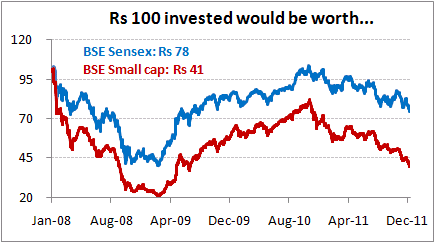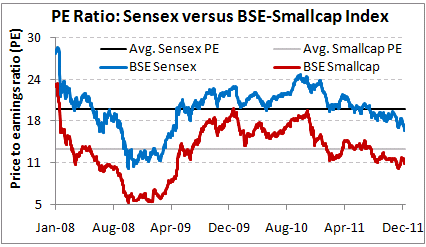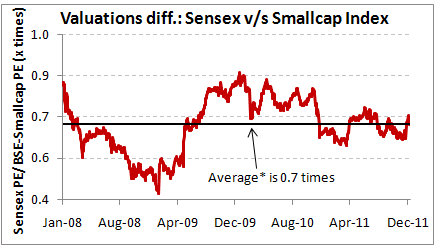The Indian stock market have seen a tumultuous 2011. The BSE Sensex has declined by 12% since the beginning of the year. But the BSE Small cap index has fared even worse. The index has declined by 42% since the dawn of the year. In this article, we will examine how the small caps have fared cheap vis-à-vis their large cap peers. More importantly we will be discussing whether the BSE-Small cap index seems overvalued or undervalued as compared to the BSE Sensex.
How much money has one made/lost?
Below we have displayed a comparative data for both the indices – BSE-Sensex and BSE-Small cap index.

Data Source: ACE Equity
If one had invested Rs 100 at the beginning of 2008 in both the Sensex and the Small-cap indices, it would have been worth Rs 78 and Rs 41 respectively. This indicates that the Sensex has outperformed the BSE-Small cap Index over this three year period. This reiterates the fact that small-caps are inherently more risky as an investment as compared to large cap or midcap stocks. Small caps may rise more than the large caps when the times are good. But they will also fall much more than the large-caps when the times are bad. This is why small caps are really not a recommended investment option to those with a low risk profile.
Nevertheless with such a substantial fall in prices, it is natural to assume that small caps have become cheaper as compared to the large cap stocks. So the next question is whether this statement is true or not.
The best way to gauge the attractiveness of stocks is to look at their price to earnings ratio (PE). This helps show if the run up in stock prices is justified vis-à-vis an increase in earnings or profits to shareholders. The same works for analyzing an index, which is nothing but a collection of stocks. Therefore, we would need to compare the valuations of the BSE-Small cap Index with the benchmark index, the BSE-Sensex.
Below is a chart indicating the PE ratios of both the indices since 2008 to date. We have also shown the average PE ratios of both these indices during this three period. Due to their inherent risky nature, there is no doubt that the BSE-Small cap Index would trade at lower valuations as compared to the BSE-Sensex. But still the question remains as to whether small caps are attractive at this point in time or not?

Data Source: ACE Equity
The answer to this question lies in the next chart which presents the comparative valuations of the two indices. The comparative valuations are calculated by dividing the PE ratio of the BSE-Small cap Index by that of the Sensex.

Data Source: ACE Equity
*Average period considered as Jan 2008 till date
Reading the chart
What does this chart tell? Well, as the ratio moves towards the 1 time mark, this means the difference in the PE ratios of the two indices is less. This could mean either of the two things. Either the Sensex is undervalued or that small caps are expensive. When the ratio moves away from the 1 time mark, it suggests that the market is paying a premium (higher than 1) or a discount (lower than 1) to the small caps as compared to the large caps. This is despite the fact that small caps are and will remain more volatile.
What should investors do at this juncture?
The comparative valuation ratio currently stands at 0.67 times. This suggests that small caps stocks, at the current levels, are fairly priced as compared to their large cap peers. But on a standalone basis, the Sensex is trading at a price to earnings of about 16.7 times which is less than its three year average of 19.3 times. At the same time, the BSE-Small cap Index is currently trading at a PE of 11.3 times which is again less than its three year average of 13.3 times. This means that there is still some steam left in both the indices to move upwards. However, considering the negative sentiment surrounding the Indian markets due to government inaction, global crisis as well as dampened corporate performance, it would take some time for the indices to get back on the upward track. However, it would be a mistake to paint all of these firms with the same brush. Even within this universe, there exist small cap stocks that possess strong competitive advantages and the ability to generate strong cash flows. Thus, you better start scuba diving in the ocean of mid and small caps. You never know, you could unearth some real gems.
By Equitymaster – India’s leading share market research initiative. Our research coverage includes both large and small companies, including the BSE Sensex stocks.
Add Comments